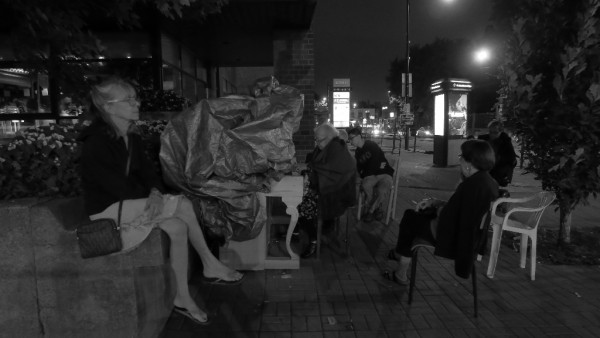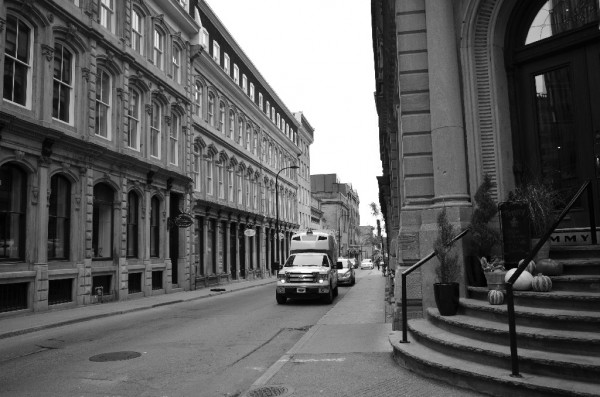Perspective
In his introduction to REPERAGES – Photographies de Alain Resnais*, the Spanish writer J. Sempruns quotes the French filmmaker A. Resnais as saying that he uses his camera as a “notebook”.
I would like to think of Resnais’ notes as narrative ideas, whereby the places he documents, would frame eventually with a film story line and with his cinematic approach.
My photographic perspective is basically a personal response to spatial poetics. Although I don’t have an a priori narrative in mind, my images document places at a crossing of present-and-historical-moments that strike me as being the nearest thing to moments of truth, defining the places’ Genius Loci.
As such the images act as an external “memory palace”* allowing a hindsight look at the experience for the sake of better understanding the place’s Genius Loci.
For example, in the feature image taken in an old industrial part of Montreal turned into a socially mixed residential area, we can detect two distinct narrative time frames:
- The historic narrative thread of that urban transformation with an old worker housing jousting first generation mid rise housing and neighboring with recent condominium development, along what used to be an industrial canal turned into a recreational and esthetic view asset for bordering property.
- The present narrative thread of moving in, or out, that can be spun around the parked rental “moving” van … probably the only truck type vehicle to be seen around there nowadays as evidence of the new residential transformation of the neighborhood.
“Moving” as the only manifest activity in a neighborhood where life once teamed in its streets as can be sensed from the front yard of the worker house, and “Moving” as the title of the photograph invites one to imagine being there.
Poetics of the street
A street is an urban circulation corridor one goes “through” and sometimes “to.sd” As such it carries pedestrian and vehicular traffic in separate zones: the pavement for vehicular parking and traffic and the sidewalks for landscaping, pedestrian traffic and activity areas tied to adjacent buildings … these basic elements “come together” on telling occasions as captured by the photographs presented below.
Depending on the time of day, day of the week and season of the year, any street will suggest different poetic readings … each one of them revealing something essential about the relations between the zones of the street and their physical properties … essential to the experience of the spirit of the street.
Main drag … Main Street 
Whereas vehicular circulation follows the “drag” effect of the street pavement, the pedestrian on the sidewalk is subject to a subtle tension between the street directionality marked by the rows of trees, cars and of the building mass, and the various “street pockets” encountered along the way that provide occasions for stopping or simply slowing down: a few chairs along the storefront of a supermarket, a street musician enchanting the entrance to a store, a church front lawn bordered by a hedge with trees joining the street trees in an overhead canopy … as in the image above … these produce a distinctive “Main Street” experience for its physical scale and its human presence i.e. its own poetics.
Night birds at the piano corner
One of these “street pockets,” located in front of the public library, harbors a summer outdoor piano as shown above.
In late summer, when the evening cools off the day’s heat, night birds will congregate around an amateur pianist … some will sit along the concrete planter’s edge, others will bring their own seats forming a circle permeable to the passer-by who has just a few moments to spare for a musical interlude … a moment of dreaming outside the urban box that is all too present with its traffic, street lights, advertisement kiosks, etc.
Let us note that during the day that street corner is occupied, off to the right of the frame, by a busy bus stop waiting line and is held together by a recently planted tree that unites and separates its two parts: one given to the traffic “going through” the street and the other given to its gathering “going to” street corner.
Depending on the time of day these two poetic poles exchange roles for animating the spirit of that street corner.
The pumpkin at the door
Old Montreal historical district has strict architectural development criteria to preserve its 19th century building pattern, when streets used to accommodate little traffic and buildings would hug the sidewalk to reduce the snow removal task in winter.
The strong architectural articulation of the building fenestration and of its floor height (“noble” functions in high ceiling floors and “banal” activity in low ceiling top floors), robustly inscribed in stone façades, provides the visual expression of human scale, in an otherwise empty street.
In such situation, a street corner becomes the place where building entrance and sidewalk may open up to each other with welcoming fan shaped entrance stair and landing. I could not help seeing the contrast between the Halloween pumpkins placed on the steps and the tourist caravan-packing semi truck coming up the street.
The feeling of loneliness caused by the visual contrast between the two historical contexts reminded me of the title of that sixties song “Where is that place called lonely street”… where is it if not floating between two eras!
Discussion: on the photographic moment
I mentioned in my last post the role of photography in capturing, expressing and documenting the spatial poetic of a place … its spirit.
Depending on the mood, the different time of day, the different scene, who knows what the photographer would stop to record and express as the spirit of the place, in a moment of heightened visual awareness: the photographic moment.
My observations have convinced me that while the spirit of a place may be embedded objectively in spatial reality, the photographer’s, or the viewer’s subjective perspective conditions its experience, as revealed in a photographic moment.
The reader may therefore wish at this point to pause and return to the images and ponder his – her own reading of the places, and their photographic moments: what other title or caption would suit? Why?
Credit all photographs Maurice Amiel, from a work in progress.
Among the photographers, whose works have consistently captured the poetics of places, and inspired mine, are the French *Depardon, the Hungarian Kertész and the American * Friedlander.
Among the architects, whose works and writings on the place phenomena have enriched my own, are the American *Donlyn Lyndon and Charles Moore.
*Pertinent bibliography
Centre National de la Photographie: André Kertész, Collection Photo Poche, 1985
Depardon, R.: Errance, Seuil, 2000
Friedlander, L.: Like a one-eyed cat, Abrams, 1989
Lyndon, D. & Moore, C.: Chambers for a memory palace, M.I.T, 1994
Resnais, A. & Sempruns, J.: REPÉRAGES: Photographies de Alain Resnais -Texte de J. Sempruns, Chêne, 1974
